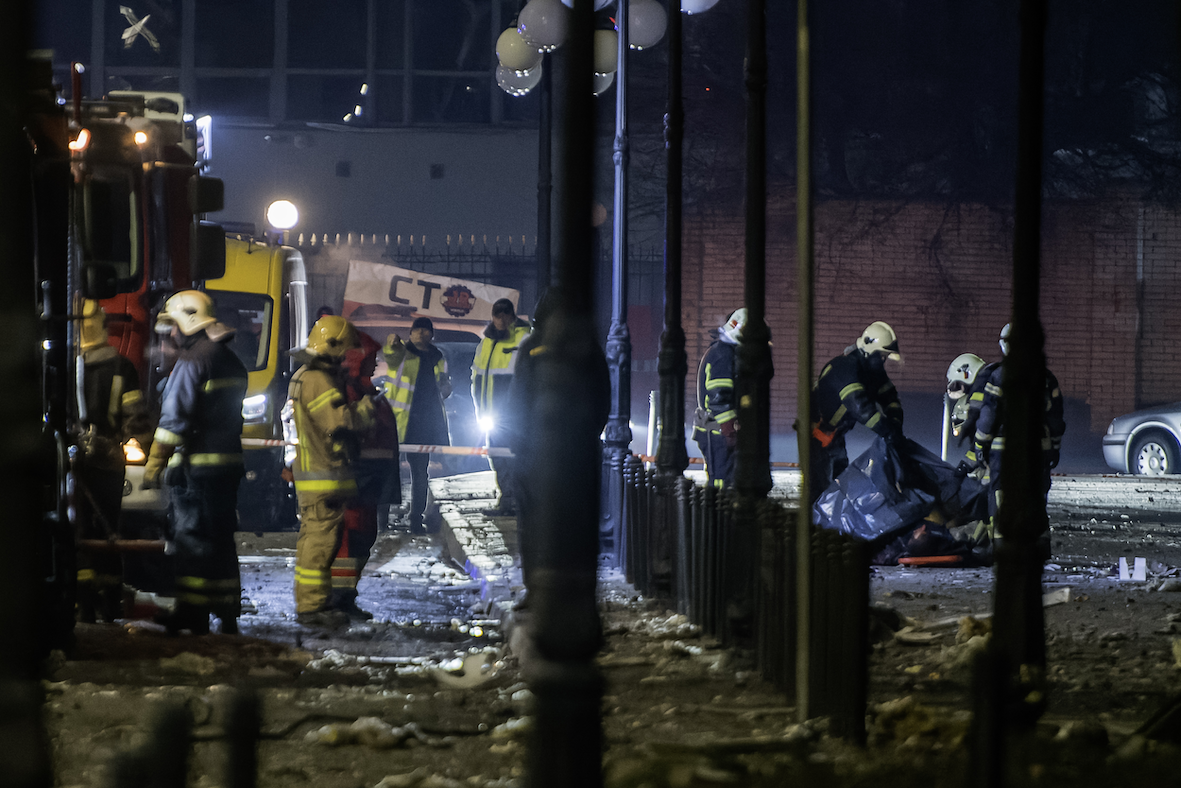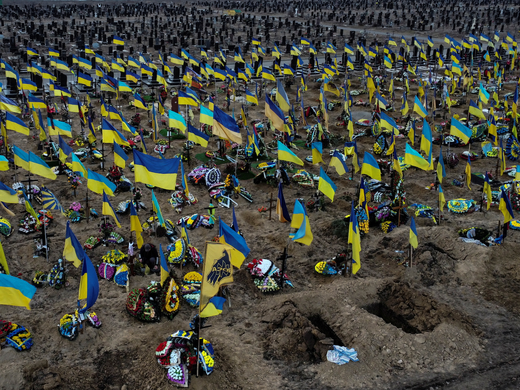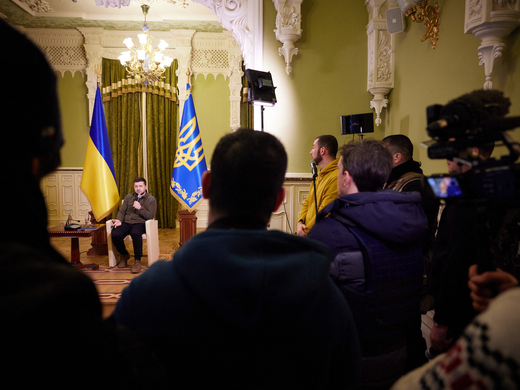Ukraine is in a fragile state. February 22 marks the three-year anniversary of its war with Russia — now with Donald Trump back in the White House. The president claims he’ll broker a ceasefire. And signs indicate Trump will push Kyiv to concede territory it has lost to Russia in exchange for vague promises of security guarantees. But it remains unclear what endgame he and his advisers have in mind, aside from Trump’s desire to be lauded for making a deal. They themselves may not even know.
Indeed, the president’s advisers now admit a peace agreement, if there is one, is likely “months away.” This is a far cry from Trump’s campaign pledge to halt the bloodshed on his first day back in office. Such uncertainty suggests Ukraine can still influence how Trump wields America’s pivotal involvement in the war — and also how other Western nations act in response.
Ukraine’s ability to defend itself has already far exceeded expectations. Multiple war games prior to the nation being invaded predicted its swift demise based on Russia’s vast superiority in soldiers and materiel. The Kremlin expected to take Kyiv in a few days and replace the sitting government with little resistance. Putin framed his attempted conquest as a “special military operation” that would “denazify” Russia’s neighbour. Russian troops brought parade uniforms in their kit.
Yet things didn’t unfold that way. Instead, Ukraine repelled Russia’s lumbering march toward its capital. It has since sustained combat operations for several years across a 1,600 km front line. Moreover, Ukrainian forces occupy Russian territory in the Kursk region. The Black Sea has become a graveyard for Russian warships, preserving transit corridors for Ukrainian exports — an economic lifeline for both Kyiv and for the Global South through uninterrupted grain shipments.
Much of this, of course, is thanks to a mountain of aid from Western nations — military equipment, ammunition and funding, as well as intelligence and personnel training. European countries and the United States alone, as of late 2024, had provided at least US$213 billion worth. Some US$147 billion more has been pledged. Foreign support from private donations and international humanitarian organizations has poured in as well.
Fundamental to securing that aid has been keeping Ukraine’s story ever visible in Western news cycles and social media feeds by generating reams of English-language digital content. Featured are arguments advocating for the global importance of upholding international norms around sovereignty, epitomized by Ukraine’s struggle. Its military’s battlefield wins are meanwhile showcased in both clips of raw footage and slick video montages.
Ukraine’s official accounts have harnessed meme culture to great effect. The country’s media organizations and civil society groups have supplied international news outlets and think tanks with a steady flow of information and analysis of dynamics on the ground. President Volodymyr Zelenskyy has criss-crossed the globe to give speeches to foreign parliaments and at the United Nations, always clad in his trademark green and grey military-style clothing. Ukrainian officials have openly acknowledged leaning into Zelenskyy’s past — a former actor turned wartime leader — to symbolize Ukraine’s underdog status in the conflict.
All told, Ukraine has reminded the world that in war, national identity matters as much as bombs and bullets. But the conflict has entered a dangerous new phase for the embattled nation. Its forces are exhausted, and it lacks the personnel and firepower to slow Russia’s incremental yet relentless advances. Meanwhile, President Trump may soon put his thumb on the scale in ceasefire talks — to Ukraine’s disadvantage.
For Ukraine, adding to that difficulty has been how identities and values within liberal democracies are increasingly contested.
Captivating and persuading Western audiences is thus essential for Ukraine to maintain the flow of foreign weapons, money, intelligence and technical support it needs to sustain its defence and accelerate its reconstruction. Otherwise, its future looks bleak.
The Roots of Ukraine’s Influence Operations
Throughout the war, Ukraine has sought to communicate a simple, straightforward narrative that paints itself as a brave and tenacious society pushing back against an unjust invasion by an imperial neighbour.
Yet a narrative is more than just a story or a series of facts. “Contemporary wars are largely wars of influence and they will not necessarily be won by those with the most information or the most accurate data,” security scholar Ajit Maan writes in her book, Narrative Warfare. “They will be won by those that effectively tell the meaning of the information and what difference it makes for the audience.” This is an immensely complex task. Indeed, influence operations will only gain traction if the narratives they construct align with the beliefs, identity, attitudes and historical perceptions of those intended to receive them.
For Ukraine, adding to that difficulty has been how identities and values within liberal democracies are increasingly contested. Ukraine’s influence operations have thus had to forge solidarity with and stitch together majority support for its cause in pluralistic nations that are themselves increasingly fractured internally. Competing groups within Western nations now don’t simply disagree with each other — they demonize each other’s position.
Ukraine’s influence operations can generally be broken down into two parallel campaigns. The first has sought to evoke compassion among Western audiences by highlighting Ukraine’s preferred narrative of collective bravery and virtue being shown via its military actions and its civic resilience. The second has emphasized negative stories about Russia — its blatant targeting of civilians and public infrastructure, desecration of cultural spaces, allegations of war crimes and repressive domestic environment.
President Zelenskyy’s refusal to be airlifted from Kyiv early on to spare himself and his family from encountering Russian death squads, for example, was instantly mythologized. “The fight is here,” he reportedly told US officials. “I need ammunition, not a ride.” It eventually became unclear whether Zelenskyy actually said this. However, the remark proved strategically effective. It established for global audiences both the urgency of the moment and the resolve of Ukraine’s leadership. That Zelenskyy conspicuously allowed himself to be photographed in downtown Kyiv — both in daylight and at night — as the invasion unfolded, reinforced his words with his actions.
Likewise, the “Ghost of Kyiv” was reportedly an ace Ukrainian fighter pilot who downed many Russian jets during the initial phase of the war. There was reason to believe this was true. Ukrainian Air Force MiG-29s were often spotted in dogfights over the capital and nearby hotspots. Yet the story was later revealed to be based on an amalgamation of missions flown by various Ukrainian pilots. That is to say, there was no one “Ghost of Kyiv” pilot after all. Rather, it was informational sleight of hand meant to inspire belief domestically and abroad in the ability of Ukraine’s heavily outgunned military to defeat a larger opponent through sheer force of will.
Both of these stories reveal a common narrative in Ukraine’s English-language influence operations early on: convincing audiences in the West that a fledgling democracy was defiantly resisting an existential threat posed by a regressive authoritarian great power.
Mass Messaging Replaced by Microtargeting
The initial stories on their own have not been sufficient to sustain the support of Western lawmakers, officials and electorates over multiple years. Ukraine’s influence campaigns have thus had to evolve both in content format and target audiences. The goal being to continuously feed the Western news cycle with new information and supply novel meaning under the umbrella of the David-versus-Goliath narrative. Ukraine has worked hard as well to position its plight as a non-partisan issue, something necessary to maintain Western support through electoral cycles.
Key to this has been coordinating a wide network of social media accounts and digital media entities. This includes United24, an online platform created by Kyiv to fundraise for its war effort. Likewise, Brand Ukraine, an independent organization that runs strategic communication projects geared toward international audiences, monitors shifts in perceptions of Ukraine throughout the world. Together, they have worked in concert to humanize Ukrainians and Ukrainian soldiers in ways Kyiv hopes will resonate with different demographics within Western societies. In particular, by tapping into the culture and values held by voters responsible for keeping pro-Ukraine lawmakers in office.
During Ukraine’s lightning counteroffensive in late 2022 to recapture the city of Kherson, and again during more grinding advances in mid-2023, social media content showed Ukrainian soldiers on combat operations, using donated Western equipment and liberating previously occupied territory. Other routinely posted content shows Ukrainian military personnel playing music with their comrades, sharing meals in foxholes, telephoning family members, dancing or making surprise visits to family in their hometowns. And there is a massive library of material. Official Ukrainian accounts on X have collectively posted tens of thousands of times since the war began. On YouTube, the United24 account alone has published more than 1,900 videos — more than one per day. The government also maintains a large image bank of professional photos of the war and its effects, made freely available for non-commercial use.
All of this material is carefully tailored into different formats to appeal to various pockets of Western society. Combat footage of soldier movements, the firing of artillery barrages or drones destroying their targets is sometimes soundtracked to electronic dance music to appeal to youth. Other times, videos are dubbed over with AC/DC or Metallica songs, catering to Gen X or older millennials. Quotes and experiences from iconic poets, authors or politicians spanning numerous nationalities are reiterated whenever President Zelenskyy is addressing a corresponding country’s parliament. Animal lovers can see Ukrainian soldiers showing off their pets. In a nod to liberal-democratic principles of gender equality, female soldiers are celebrated for their crucial contributions in various wartime roles, from medical support to front-line combat. There is also an abundance of self-deprecation.
Western conservatives are an important group given how ultranationalist voices on the right — especially within the US Republican Party — are seeking to sever support for Kyiv. Ukrainian content tries to temper this shift by frequently making references to the importance of family and parenthood. Images of the destruction of churches, cathedrals and monasteries show an assault on Ukraine’s religious practice and faith. Republican political leaders are presented positively in Ukrainian content and commentary. The hashtag #FreedomIsOurReligion tags some Ukrainian content, making clear appeals to Republican voters with an emphasis on overt declarations of religion.
Supporting all of these efforts have been allied grassroots entities. The North Atlantic Fellas Organization — or NAFO — is one. The online community comprised of thousands of individual users generates pro-Ukraine content, sells merchandise and trolls Russian diplomats on social media.
There are also myriad pro-Ukraine open-source intelligence accounts that share combat footage leaked from Ukrainian sources. These accounts have more leeway to present extreme content tacitly endorsed by Kyiv, yet the type of material official Ukrainian channels shy away from. For example, graphic imagery and videos of Russian military personnel being stalked and killed by drones or air-dropped munitions are sometimes shared. Or first-person views from infantry helmet cams that show Russian targets being shot to death at close range, often in trenches or in buildings. These videos are notable for their frenetic style and synth-music dub overs that cater toward a niche younger, predominantly male audience immersed in video-game culture. The content bears an uncanny and often brutal resemblance to popular military first-person shooter games, such as the Call of Duty and Counter-Strike franchises.
Ukraine has also been adept at earning media exposure through international television, radio, print and digital channels. Western media outlets such as Bloomberg, CNN, Fox News, BBC, CBC, SkyNews and Deutsche Welle, as well as The Atlantic, The Guardian, The New York Times, The Globe and Mail, The Economist and many others have easy access to the country’s roster of officials, ambassadors, academics and military brass. Likewise, Western analysts, policy makers, reporters and intellectuals have been given extensive tours of combat theatres and command centres in Ukraine. Ukrainian soldiers have affixed American flags to their chests during filmed interviews.
Ukrainian media also repurposes earned media in foreign outlets for domestic consumption. An early example of this tactic came in March 2022 when a pilot with the call sign “Juice” appeared on CNN to discuss the mindset driving him and his colleagues to carry out high-risk missions. The broadcast was reshared the next day on social media by Ukraine’s defence ministry, leveraging the credibility conveyed by a legacy global media brand for its own storytelling purposes. Images gathered and shared by Ukrainian sources of alleged Russian war crimes have also regularly been picked up by international television and print media.
There are more factors influencing attitudes and perceptions about Ukraine than its campaigns alone.
Ukraine is developing and delivering its messaging in a way that is familiar with many political campaigns: defining a broad idea — or a narrative — and connecting that narrative with tailored messages that appeal to people with different backgrounds and interests. The goal being to build a coalition of support around one central idea from a wide base comprised of subsegments of the population.
A New Form of Persuasion?
Ukraine’s efforts are important for a number of reasons.
First, most contemporary research and policy discussions around digital influence in the social media era have focused on how adversaries target Western countries — not how friendly states conduct campaigns to persuade each other. Rather, much of the discourse over the past decade has focused on hostile groups targeting Western countries.
Much has also been written about the methods and rhetoric extremist groups use to radicalize and recruit online, be it Islamist terrorists or far-right militias and white supremacist cells. But Ukraine is clearly not engaged in radicalization of Western publics. Nor is it exercising malign influence in Western politics — as much as Kyiv’s critics would denounce its activities as spreading propaganda. There is no call to violence against Russians living in the West. And campaigns are carried out in the open, backed by evidence and are clearly attributable to Ukraine.
Second, Ukraine has been able to build and control its narrative around the war much more effectively among foreign audiences than it would have solely relying on the international press.
By investing in the production of its own content and broadcasting that on its own terms — Zelenskyy walking the streets of Kyiv during the invasion; soldiers liberating villages; high-speed, low-altitude helicopter attack missions; artillery volleys; drone footage; reconstruction efforts; civilians huddled in subway stations; moments of joy amid despair — Ukraine delivers more than just facts. It delivers a coherent narrative. Moreover, this content is often used by journalists to inform their own reporting, infusing Ukraine’s perspective and narrative into reports by global outlets.
Measuring the effectiveness of all of this is immensely difficult. There are more factors influencing attitudes and perceptions about Ukraine than its campaigns alone. However, there’s ample reason to believe they have contributed to Ukraine outperforming expectations in the war — both in drawing an estimated 20,000 fighters from some 50 countries to join its foreign legion, and in getting generally sustained supplies of equipment, weapons and ammunition from Western nations. Ukraine also continues to conduct influence operations, implying its leadership certainly sees the value in allocating time and resources to convince the West to send supplies. This remains true even if that material has generally arrived too late and in too small quantities.
European governments, for example, were reluctant to provide lethal aid to Ukraine at all until being confronted two months into the war by horrific visual evidence of Russian atrocities in the occupied town of Bucha. In 2024, Ukraine finally received the F-16 fighter jets Kyiv had been asking for since 2022, as well as the longer-range ATACMS artillery rounds that were slow-walked by the Biden administration. And while the country has not received everything it has asked for, it has received enough to essentially transition from Soviet-era munitions stocks to modern NATO-standard weapons systems across a range of categories. And all within less than three years.
Support for Ukraine in the West has also survived numerous changes of government. It was prevalent during the US presidential campaign, drawing renewed pledges of support from mainstream Democrats — even though their candidate, former vice-president Kamala Harris, eventually lost. The Biden administration, in its twilight, authorized another US$2.5 billion in military aid. Germany’s opposition leader, conservative Friedrich Merz, the frontrunner to become the country’s next chancellor after elections on February 23, has vowed to stop forcing Ukraine “to fight with one hand tied behind [its] back” by delivering long-range Taurus cruise missiles. Both Britain and France continue to send weapons and ammunition to Ukraine despite multiple changes in government. Voters in liberal democracies, including Canada, will be facing elections soon.
Indeed, a study by Humanities and Social Sciences Communications published in January suggested that exposure to information about civilian harm in Ukraine had increased empathy for Ukraine and was a major factor behind public support in America for US involvement in the war.
Ukraine’s Vulnerabilities Will Motivate More Influence Campaigns
Kyiv’s wartime experience underscores how influence operations are not exclusively used for malign purposes against an adversary. Rather, they are an effective — and legitimate — tool of statecraft to be deployed in pursuit of strategic political objectives. In this light, Ukraine has pioneered several ways of presenting a chosen narrative to the world using official channels, earned media and decentralized grassroots allies to spread messages that appeal across age, gender, partisan, religious and socio-economic boundaries.
But Ukraine now faces its biggest challenge: convincing Trump to avoid sacrificing its interests by brokering a rushed truce with Moscow. Zelenskyy met Trump in Paris at the reopening of the Notre-Dame Cathedral in December 2024 to make a pitch for America’s continued support. “President Trump is, as always, resolute,” the Ukrainian leader posted flatteringly on X after the meeting.
A few weeks later, Zelenskyy played up Trump’s capacity as a dealmaker in an interview to Polish media, knowing it would get picked up by American press. Ukraine then sent a delegation in early February to the National Prayer Breakfast in Washington, DC — hoping to sway Christian conservatives, including many in the Trump administration, to pledge continued support.
Events then took a sharp turn after this month’s heated Munich Security Conference. Zelenskyy and European leaders pushed back against Trump’s team for saying the United States alone would negotiate a deal directly with Russia in talks that began in Riyadh, Saudi Arabia, on February 18. The next day, Trump on social media blamed Ukraine for starting the war, calling Zelenskyy a “Dictator without Elections.” Yet many senior Republicans immediately rushed to Ukraine’s defence.
“One of Ukraine’s most valuable resources is the goodwill of the West,” wrote a former New York Times bureau chief in December after a recent reporting trip to Ukraine, “and many people I met seemed acutely conscious that everything could depend on the way their war is framed in Trump’s mind.” Key, then, to Ukraine’s evolving influence operations could be persuading Trump that “China, which has become an indispensable supplier for Russia, would be emboldened if Russia wins, and might go on to challenge American power in the Pacific.”
But Putin is winning on the battlefield and remains committed to annihilating Ukraine’s sovereignty. He has little incentive to negotiate in good faith — even as his war machine consumes the Russian economy. Indeed, any ceasefire is likely to be weaponized by Putin as a means to rearm and reset his maximalist imperial agenda. Nevertheless, popular support in Europe for a ceasefire is steadily rising.
For nearly three years, Ukraine has combined the principles of persuasion to build a compelling narrative, while using the full range of digital information technologies and legacy media outlets to galvanize support for itself among dozens of subsegmented audiences throughout the West. How its conflict with Russia ends is yet to be determined. But long after it does, the war will continue to provide many lessons on the application of digital technologies — both for combat operations and for shaping global opinion.



